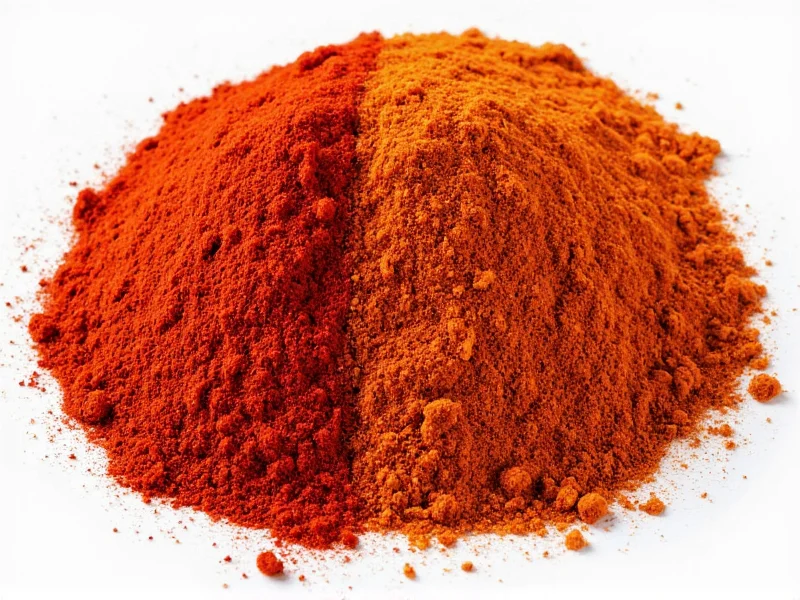Understanding the distinction between sweet paprika and regular paprika is essential for precise cooking results. Many home chefs encounter confusion when recipes specify one type over the other, potentially altering dish outcomes significantly. This comprehensive guide clarifies the botanical origins, flavor chemistry, and culinary applications that differentiate these spice varieties.
Decoding Paprika Terminology
The term ‘paprika’ encompasses multiple varieties produced from ground Capsicum annuum peppers. This broad categorization creates frequent misunderstanding, as ‘paprika’ without specification could mean:
- Sweet paprika (0-100 SHU) - exclusively sweet peppers
- Regular/Hungarian paprika (0-500 SHU) - blend of sweet and mildly hot peppers
- Hot paprika (500-1,500 SHU) - includes significant hot pepper content
- Smoked paprika (varies) - dried over oak fires
When recipes simply call for ‘paprika,’ they typically mean standard Hungarian paprika – a balanced variety with subtle warmth but no pronounced heat. This distinction between sweet paprika and paprika varieties explains why substitution errors commonly occur in home cooking.
Sweet Paprika: Characteristics and Production
Sweet paprika originates from specific sweet pepper cultivars grown in optimal conditions, primarily in Hungary’s Kalocsa and Szeged regions. These peppers undergo careful selection, ripening to deep red before harvesting. The production process involves:
- Hand-picking fully matured sweet peppers
- Air-drying at controlled temperatures (40-60°C)
- Stone-grinding to preserve volatile compounds
- Sifting to achieve fine, consistent texture
The resulting spice displays vibrant red color (measuring 1,800-2,200 ASTA color units) and delivers a pure, sweet pepper flavor with subtle berry notes. With zero Scoville heat units, it provides color and flavor without any warming sensation – making it ideal for dishes where heat would be undesirable.
Standard Paprika: The Versatile Middle Ground
When cooks reference ‘paprika’ without qualification, they usually mean standard Hungarian paprika. This variety blends sweet peppers with small percentages of mildly pungent varieties (typically 5-15%). Key characteristics include:
- Mild warmth (100-500 SHU) – noticeable but not spicy
- Complex flavor profile with sweet base and subtle earthy finish
- Slightly darker red hue than sweet paprika (1,600-2,000 ASTA)
- Essential in traditional Hungarian goulash and fisherman’s soup
This standard paprika vs sweet paprika difference explains why Hungarian chefs maintain separate containers for each variety. The mild heat in standard paprika activates different flavor receptors, creating more complex taste experiences in slow-cooked dishes.
Comparative Analysis
| Characteristic | Sweet Paprika | Standard Paprika |
|---|---|---|
| Heat Level (SHU) | 0 | 100-500 |
| Primary Pepper Types | Sweet red peppers only | Mixture of sweet and mild hot peppers |
| Color Intensity (ASTA) | 1,800-2,200 | 1,600-2,000 |
| Flavor Profile | Pure sweet pepper, subtle berry notes | Sweet base with earthy, slightly warm finish |
| Traditional Uses | Coloring deviled eggs, potato salads, light sauces | Goulash, stews, meat rubs, traditional Hungarian dishes |
| Substitution Impact | Creates milder, sweeter results | Adds subtle warmth and complexity |
Culinary Applications and Substitution Guidance
Understanding the difference between sweet paprika and regular paprika prevents recipe failures. Consider these practical applications:
Sweet paprika excels in:
- Coloring without altering flavor profile (deviled eggs, potato salad)
- Light-colored sauces where heat would be disruptive
- Marinades for delicate proteins like chicken or fish
- Balancing acidity in tomato-based dishes without adding heat
Standard paprika shines in:
- Traditional Hungarian dishes requiring subtle warmth
- Meat rubs where complexity enhances seared surfaces
- Slow-cooked stews allowing flavors to develop gradually
- Dishes needing both color and mild flavor enhancement
When substituting between sweet paprika and paprika varieties, remember:
- Replacing standard with sweet paprika removes subtle warmth – compensate with pinch of cayenne
- Using standard instead of sweet adds mild heat – reduce by 25% when substituting
- Smoked paprika creates entirely different flavor profile – not a direct substitute
- Always measure by weight, not volume, for consistent results
Regional Variations and Quality Indicators
Paprika production varies globally, affecting the sweet paprika vs regular paprika distinction:
Hungarian Paprika: The gold standard, with protected geographical indication (PGI) status for Kalocsa and Szeged varieties. Authentic Hungarian paprika displays:
- Deep, consistent red color (no orange or brown tones)
- Strong sweet pepper aroma when rubbed between fingers
- Smooth texture without gritty particles
- Packaged in dark glass or opaque containers to preserve quality
Spanish Paprika (Pimentón): Primarily refers to smoked varieties (dulce, agridulce, picante), creating confusion in the sweet paprika vs paprika comparison. Spanish sweet paprika (pimentón dulce) has distinct smokiness absent in Hungarian varieties.
American Paprika: Often blends Hungarian and California peppers, resulting in milder flavor profiles. Check labels for ‘sweet’ specification when precise heat control matters.
Storage and Freshness Preservation
Both sweet paprika and standard paprika lose potency rapidly when exposed to elements. Follow these storage guidelines:
- Transfer from paper packets to airtight glass containers immediately
- Store in cool, dark place (not above the stove)
- Refrigerate in humid climates to prevent moisture absorption
- Replace every 6-12 months – stale paprika turns brown and loses aroma
- Test freshness by rubbing 1/4 tsp between palms – fresh paprika releases strong pepper scent
Properly stored, high-quality sweet paprika maintains its pure sweet profile longer than standard varieties, which may experience flavor separation as volatile compounds degrade.
Practical Cooking Tips
Maximize the difference between sweet paprika and paprika in your cooking:
- Bloom both varieties in oil first to release full flavor compounds
- Add sweet paprika late in cooking to preserve delicate flavor
- Use standard paprika early in slow-cooked dishes to develop complexity
- Combine both varieties for layered flavor profiles (2 parts standard to 1 part sweet)
- Never cook either variety above 175°C to prevent bitterness











 浙公网安备
33010002000092号
浙公网安备
33010002000092号 浙B2-20120091-4
浙B2-20120091-4